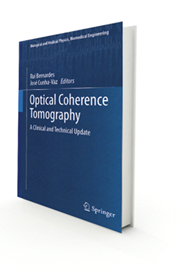This book is a comprehensive review of the clinical and scientific aspects of optical coherence tomography (OCT). The 255 pages are divided into 11 chapters, each written by a different group of authors. Part I provides viewpoints on the clinical aspects of OCT from reputed ophthalmologists, and Part II examines the technology in more detail and looks at future developments.
The book begins by looking at OCT from a historical perspective, charting the progress from time-domain to spectral-domain OCT (SD-OCT), with the benefits of improved axial resolution, acquisition speed and 3D imaging. A comparison of current SD-OCT machines is made. In the context of diabetic macula oedema, significant differences between instruments, such as variations in macular thickness acquisition protocols and normative data for central retinal thickness are described.
The book continues by looking at a number of important clinical applications of OCT, such as the capability to detect ischaemic retinal damage. This concept is supported by a number of clinical examples, with useful direct correlation of OCT and fluorescein angiography imaging. The benefits of improved resolution in the ability to assess the integrity of the retinal pigment epithelium (RPE) and photoreceptor inner segment / outer segment junction as prognostic markers in a variety of medical and surgical retinal conditions is also discussed.
A particular focus is the role of OCT in age-related macular degeneration (AMD), with description of the morphological characterisation of drusen as a potential imaging biomarker for the risk of disease progression, and the development of segmentation algorithms to allow quantification of drusen. The clinical section concludes with the use of OCT in the quantitative assessment of optic nerve damage and retinal nerve fibre layer thinning in glaucoma, and the role of anterior segment OCT in refractive surgery.
Part II focuses on the technical aspects of OCT and introduces advanced physical and mathematical concepts. There are also some very interesting new fields of application discussed, such as the role of OCT in assessing the integrity of the blood retinal barrier. Other technologies not currently available commercially including adaptive optics, slit-lamp-integrated OCT, and polarisation sensitivity OCT are discussed in detail. The ability to detect changes in light’s polarisation state to generate tissue-specific contrast is an exciting development from ‘intensity-based’ OCT, as it will allow improved segmentation of ocular structures and quantitative analysis of disease progression. One interesting example described is the automatic segmentation and detection of subretinal fluid related to choroidal neovascularisation (CNV) to assess the affect of anti-VEGF treatment.
This book is well written and each chapter is extensively referenced, with unexpected but welcome recaps on clinical ophthalmology and retinal physiology along the way. The book is also richly complemented with 124 colour and grey-scale figures which are generally of good quality although at times some images appear too small and difficult to interpret, adding little to the narrative. The main problem with this book though is that it does not completely fulfil its objective of ‘bridging the gap’ between the medical and technical communities because the target audience is too wide-ranging. Only the most scientifically literate clinicians will fully get to grips with the second half of this book and therefore feel completely satisfied with an outlay of £90.




